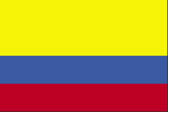Andean America is a territorial portion of South America. It receives this name because it is cut by the Andes Mountains, which extends from north to south of the subcontinent. The countries that make up Andean America are: Bolivia, Chile, Colombia, Ecuador, Peru and Venezuela.
These countries correspond to a territorial extension of 5.3 million square kilometers, being inhabited by approximately 144 million people. The majority of the population (70%) is composed of Amerindians and mestizos, a consequence of the miscegenation between the Indian (native population) and the white (European colonizer).
The climate in Andean America varies according to the proximity of the Andes Mountains. In the north-south direction, the registered climates are: equatorial, tropical, desert (south of Peru and north of Chile), Mediterranean and temperate (decreasing temperatures towards the south of Chile).
Agricultural and extractive production are the main economic activities in the Andean countries, being responsible for absorbing the labor of a large portion of the population. The fishing activity in Peru stands out because it is considered one of the largest fish producers in the world.
Chile is a large copper producer. Venezuela, in turn, has large oil reserves, being a large producer and exporter of the product, whose nation is part of the Organization of Petroleum Exporting Countries (OPEC). Ecuador is also a major oil producer, however, it is not part of OPEC. In Bolivia, the exploration of tin and natural gas stands out.
One downside is that Colombia, Bolivia and Peru are one of the world's top three cocaine producers.
The industrial sector is underdeveloped, with Chile being the main representative of this segment of the economy. Industry in Andean America is based on textile, food, metallurgy, beverage and agricultural products.
The Andean Community is an economic bloc formed by the countries of Andean America. Its creation had as main objective, the economic strengthening of the member countries, having as main members: Bolivia, Colombia, Ecuador and Peru. Chile joined the bloc between 1969-1976, and Venezuela was a member country between 1973-2006.
Data from Andean countries:
Do not stop now... There's more after the advertising ;)
Bolivia
Area: 1,098,581 km²
Population: 9,862,860
Demographic density: 9 inhab./km²
Language: Spanish, Quinchua and Aymara.
Currency: Bolivian
Capital: La Paz
Life expectancy: 65 years
HDI: 0.643
GDP: 16.7 billion dollars.
Chile
Area: 756,945 km²
Population: 16,970,265 inhabitants
Demographic density: 22 inhab./km²
Spanish language.
Currency: Peso
Capital: Santiago
Life expectancy: 78 years
HDI: 0.783
GDP: 169.4 billion dollars.
Colombia
Area: 1,138,914 km²
Population: 45,659,709 inhabitants
Demographic density: 40 inhab./km²
Spanish language.
Currency: Colombian Peso
Capital: Bogota
Life expectancy: 72 years
HDI: 0.689
GDP: 242.2 billion dollars.
Ecuador
Area: 283,561 km²
Population: 13,625,069 inhabitants
Demographic density: 48 inhab./km²
Spanish language.
Currency: US Dollar
Capital: Quito
Life expectancy: 74 years
HDI: 0.695
GDP: 52.6 billion dollars.
Peru
Area: 1,285,216 km²
Population: 29,164,883 inhabitants
Demographic density: 22 inhab./km²
Language: Spanish, Quinchua, Aymara
Currency: New Sun
Capital: Lima
Life expectancy: 71 years
HDI: 0.723
GDP: 127.4 billion dollars.
Venezuela
Area: 912,050 km²
Population: 28,853,366 inhabitants
Demographic density: 31 inhab./km²
Spanish language
Currency: Venezuelan Bolivar
Capital: Caracas
Life expectancy: 73 years
HDI: 0.696
GDP: 313.8 billion dollars.
By Wagner de Cerqueira and Francisco
Graduated in Geography
Brazil School Team
America - continents - geography - Brazil School
Would you like to reference this text in a school or academic work? Look:
FRANCISCO, Wagner de Cerqueira and. "Andean America"; Brazil School. Available in: https://brasilescola.uol.com.br/geografia/america-andina.htm. Accessed on June 27, 2021.
